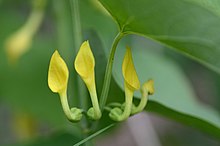Aristolochia clematitis
| Aristolochia clematitis | |
|---|---|
 |
|
| Scientific classification | |
| Kingdom: | Plantae |
| Clade: | Angiosperms |
| Clade: | Magnoliids |
| Order: | Piperales |
| Family: | Aristolochiaceae |
| Genus: | Aristolochia |
| Species: | A. clematitis |
| Binomial name | |
|
Aristolochia clematitis L. |
|
Aristolochia clematitis, the (European) birthwort, is a twining herbaceous plant in the Aristolochiaceae family, which is native to Europe. The leaves are heart shaped and the flowers are pale yellow and tubular in form. The plant seeks light by ascending the stems of surrounding plants.
It was formerly used as a medicinal plant, though it is poisonous, and is now occasionally found established outside of its native range as a relic of cultivation. It is now thought to be the cause of thousands of kidney failures in Romania, Bulgaria, Serbia, Bosnia and Herzegovina and Croatia where the plant is thought to be unintentionally consumed through contaminated flour. Urinary tract malignacies among those who have consumed the plant are also reported. The link between renal failure and aristolochic acid, which the plant contains, was discovered after a clinic for obesity in Belgium used herbal products based on another plant of the same genus as a diuretic. After a few months, some of the patients experienced kidney failure.
...
Wikipedia
